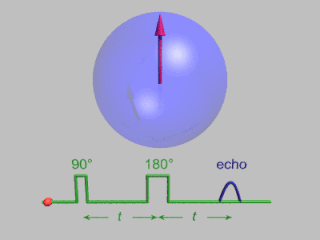Related Research Articles

Compton scattering, discovered by Arthur Holly Compton, is the scattering of a photon by a charged particle, usually an electron. If it results in a decrease in energy of the photon, it is called the Compton effect. Part of the energy of the photon is transferred to the recoiling electron. Inverse Compton scattering occurs when a charged particle transfers part of its energy to a photon.

Fermi liquid theory is a theoretical model of interacting fermions that describes the normal state of most metals at sufficiently low temperatures. The interactions among the particles of the many-body system do not need to be small. The phenomenological theory of Fermi liquids was introduced by the Soviet physicist Lev Davidovich Landau in 1956, and later developed by Alexei Abrikosov and Isaak Khalatnikov using diagrammatic perturbation theory. The theory explains why some of the properties of an interacting fermion system are very similar to those of the ideal Fermi gas, and why other properties differ.

A magnon is a quasiparticle, a collective excitation of the electrons' spin structure in a crystal lattice. In the equivalent wave picture of quantum mechanics, a magnon can be viewed as a quantized spin wave. Magnons carry a fixed amount of energy and lattice momentum, and are spin-1, indicating they obey boson behavior.
High resolution electron energy loss spectroscopy (HREELS) is a tool used in surface science. The inelastic scattering of electrons from surfaces is utilized to study electronic excitations or vibrational modes of the surface of a material or of molecules adsorbed to a surface. In contrast to other electron energy loss spectroscopies (EELS), HREELS deals with small energy losses in the range of 10−3 eV to 1 eV. It plays an important role in the investigation of surface structure, catalysis, dispersion of surface phonons and the monitoring of epitaxial growth.
A spin wave is a propagating disturbance in the ordering of a magnetic material. These low-lying collective excitations occur in magnetic lattices with continuous symmetry. From the equivalent quasiparticle point of view, spin waves are known as magnons, which are bosonic modes of the spin lattice that correspond roughly to the phonon excitations of the nuclear lattice. As temperature is increased, the thermal excitation of spin waves reduces a ferromagnet's spontaneous magnetization. The energies of spin waves are typically only μeV in keeping with typical Curie points at room temperature and below.
X-ray absorption near edge structure (XANES), also known as near edge X-ray absorption fine structure (NEXAFS), is a type of absorption spectroscopy that indicates the features in the X-ray absorption spectra (XAS) of condensed matter due to the photoabsorption cross section for electronic transitions from an atomic core level to final states in the energy region of 50–100 eV above the selected atomic core level ionization energy, where the wavelength of the photoelectron is larger than the interatomic distance between the absorbing atom and its first neighbour atoms.

Neutron spin echo spectroscopy is an inelastic neutron scattering technique invented by Ferenc Mezei in the 1970s, and developed in collaboration with John Hayter. In recognition of his work and in other areas, Mezei was awarded the first Walter Haelg Prize in 1999.

In magnetic resonance, a spin echo is the refocusing of spin magnetisation by a pulse of resonant electromagnetic radiation. Modern nuclear magnetic resonance (NMR) and magnetic resonance imaging (MRI) make use of this effect.
Helium atom scattering (HAS) is a surface analysis technique used in materials science. HAS provides information about the surface structure and lattice dynamics of a material by measuring the diffracted atoms from a monochromatic helium beam incident on the sample.

In solid state physics, a surface phonon is the quantum of a lattice vibration mode associated with a solid surface. Similar to the ordinary lattice vibrations in a bulk solid, the nature of surface vibrations depends on details of periodicity and symmetry of a crystal structure. Surface vibrations are however distinct from the bulk vibrations, as they arise from the abrupt termination of a crystal structure at the surface of a solid. Knowledge of surface phonon dispersion gives important information related to the amount of surface relaxation, the existence and distance between an adsorbate and the surface, and information regarding presence, quantity, and type of defects existing on the surface.
Giacinto Scoles is a European and North American chemist and physicist who is best known for his pioneering development of molecular beam methods for the study of weak van der Waals forces between atoms, molecules, and surfaces. He developed the cryogenic bolometer as a universal detector of atomic and molecule beams that not only can detect a small flux of molecules, but also responds to the internal energy of the molecules. This is the basis for the optothermal spectroscopy technique which Scoles and others have used to obtain very high signal-to noise and high resolution ro-vibrational spectra.
Inelastic electron tunneling spectroscopy (IETS) is an experimental tool for studying the vibrations of molecular adsorbates on metal oxides. It yields vibrational spectra of the adsorbates with high resolution (< 0.5 meV) and high sensitivity (< 1013 molecules are required to provide a spectrum). An additional advantage is the fact that optically forbidden transitions may be observed as well. Within IETS, an oxide layer with molecules adsorbed on it is put between two metal plates. A bias voltage is applied between the two contacts. An energy diagram of the metal-oxide-metal device under bias is shown in the top figure. The metal contacts are characterized by a constant density of states, filled up to the Fermi energy. The metals are assumed to be equal. The adsorbates are situated on the oxide material. They are represented by a single bridge electronic level, which is the upper dashed line. If the insulator is thin enough, there is a finite probability that the incident electron tunnels through the barrier. Since the energy of the electron is not changed by this process, it is an elastic process. This is shown in the left figure.
Nuclear magnetic resonance (NMR) in porous materials covers the application of using NMR as a tool to study the structure of porous media and various processes occurring in them. This technique allows the determination of characteristics such as the porosity and pore size distribution, the permeability, the water saturation, the wettability, etc.

Resonant inelastic X-ray scattering (RIXS) is an X-ray spectroscopy technique used to investigate the electronic structure of molecules and materials.
The proton spin crisis is a theoretical crisis precipitated by an experiment in 1987 which tried to determine the spin configuration of the proton. The experiment was carried out by the European Muon Collaboration (EMC).

Elias "Eli" Burstein was an American experimental condensed matter physicist whose active career in science spanned seven decades. He is known for his pioneering fundamental research in the optical physics of solids; for writing and editing hundreds of articles and other publications; for bringing together scientists from around the world in international meetings, conferences, and symposia; and for training and mentoring dozens of younger physicists.
Neutron resonance spin echo is a quasielastic neutron scattering technique developed by Gähler and Goloub. In its classic form it is used analogously to conventional neutron spin echo (NSE) spectrometry for quasielastic scattering where tiny energy changes from the sample to the neutron have to be resolved. In contrast to NSE, the large magnetic solenoids are replaced by two resonant flippers respectively. This allows for variants in combination with triple axes spectrometers to resolve narrow linewidth of excitations or MIEZE for depolarizing conditions and incoherent scattering which are not possible with conventional NSE.

The scanning helium microscope (SHeM) is a novel form of microscopy that uses low energy neutral helium atoms to image the surface of a sample without any damage to the sample caused by the imaging process. Since helium is inert and neutral, it can be used to study delicate and insulating surfaces. Images are formed by rastering a sample underneath an atom beam and monitoring the flux of atoms that are scattered into a detector at each point.

John Ellis is the current director of studies for Natural Sciences at the Gonville and Caius College, Cambridge. He was born in London in 1963 and is best known for his research on Helium-3 surface spin echo, an inelastic scattering technique.

Jonas Alster is an Israeli nuclear physicist.
References
- ↑ Kole, P.R.; Jardine, A.P.; Hedgeland, H.; Alexandrowicz, G. (2010). "Measuring surface phonons with a 3He spin echo spectrometer: a two-dimensional approach". J. Phys.: Condens. Matter. 22 (304018): 304018. doi:10.1088/0953-8984/22/30/304018. PMID 21399350.
- ↑ Alexandrowicz, G.; Jardine, A.P. (2007). "Helium spin echo spectroscopy: studying surface dynamics with ultra-high-energy resolution". J. Phys.: Condens. Matter. 19 (305001): 305001. doi:10.1088/0953-8984/19/30/305001.
- ↑ Jardine, A.P.; Hedgeland, H.; Alexandrowicz, G.; Allison, W.; Ellis, J. (2009). "Helium-3 spin-echo: Principles and application to dynamics at surfaces". Prog. Surf. Sci. 84 (11–12): 323–379. doi:10.1016/j.progsurf.2009.07.001.
- ↑ Jardine, A.P.; Lee, E.Y.M.; Ward, D.J.; Alexandrowicz, G.; Hedgeland, H.; Allison, W.; Ellis, J.; Pollak, E. (24 September 2010). "Determination of the Quantum Contribution to the Activated Motion of Hydrogen on a Metal Surface: H/Pt(111)". Phys. Rev. Lett. 105 (136101): 136101. doi:10.1103/physrevlett.105.136101. PMID 21230789.
- ↑ McIntosh, Eliza; Wikfeldt, K. Thor; Ellis, John; Michaelides, Angelos; Allison, William (April 19, 2013). "Quantum Effects in the Diffusion of Hydrogen on Ru(0001)". J. Phys. Chem. Lett. 4 (9): 1565–1569. doi:10.1021/jz400622v. PMC 4047567 . PMID 24920996.
- ↑ Lechner, B.A.J.; Kole, P.R.; Hedgeland, H.; Jardine, A.P.; Allison, W.; Hinch, B.J.; Ellis, J. (2014). "Ultra-high precision determination of site energy differences using a Bayesian method" (PDF). Phys. Rev. B. 89 (121405(R)). doi:10.1103/PhysRevB.89.121405.
- ↑ Hedgeland, H.; Kole, P.R.; Davies, H.R.; Jardine, A.P.; Alexandrowicz, G.; Allison, W.; Ellis, J.; Fratesi, G.; Brivio, G.P. (2009). "Surface dynamics and friction of K/Cu(001) characterized by helium-3 spin-echo and density functional theory" (PDF). Phys. Rev. B. 80 (125426). doi:10.1103/PhysRevB.80.125426. hdl: 2434/442441 .
- ↑ Alexandrowicz, G.; Jardine, A.P.; Hedgeland, H.; Allison, W.; Ellis, J. (10 October 2006). "Onset of 3D collective surface diffusion in the presence of lateral interactions: Na/Cu(001)". Phys. Rev. Lett. 97 (156103): 156103. Bibcode:2006PhRvL..97o6103A. doi:10.1103/PhysRevLett.97.156103. PMID 17155343.
- ↑ Alexandrowicz, Gil; Kole, Pepijn R.; Lee, Everett Y.M.; Hedgeland, Holly; Ferrando, Riccardo; Jardine, Andrew P.; Allison, William; Ellis, John (May 6, 2008). "Prev. Article Next Article Table of Contents Observation of Uncorrelated Microscopic Motion in a Strongly Interacting Adsorbate System". J. Am. Chem. Soc. 130 (21): 6789–6794. doi:10.1021/ja800118x. PMID 18457388.
- ↑ Riley, D.; Jardine, A.P.; Dworski, S.; Alexandrowicz, G.; Fouquet, P.; Ellis, J.; Allison, W. (13 March 2007). "A refined He–LiF(001) potential from selective adsorption resonances measured with high-resolution helium spin-echo spectroscopy". J. Chem. Phys. 126 (104702): 104702. doi:10.1063/1.2464087. PMID 17362076.
- ↑ Tuddenham, F.E.; Hedgeland, H.; Knowling, J.; Jardine, A.P.; Maclaren, D.A.; Alexandrowicz, G.; Ellis, J.; Allison, W. (11 June 2009). "Linewidths in bound state resonances for helium scattering from Si(111)–(1 × 1)H" (PDF). J. Phys.: Condens. Matter. 21 (26): 264004. doi:10.1088/0953-8984/21/26/264004. PMID 21828452.